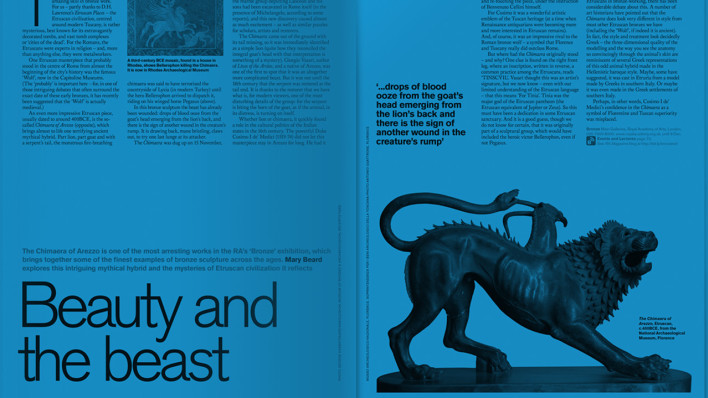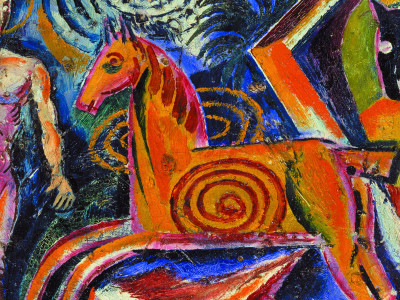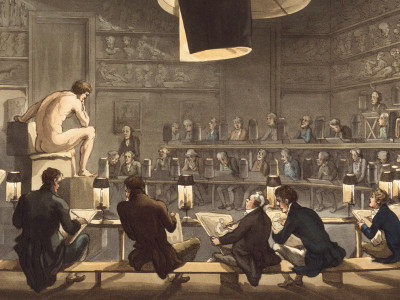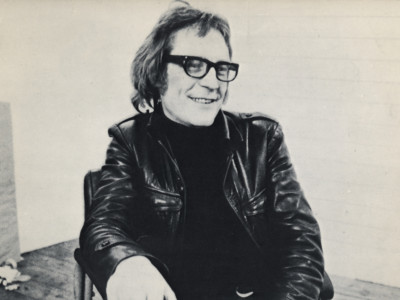
Black artists in British art
By Richard Cork
Published on 15 September 2014
An insight into Eddie Chambers's 'Black Artists in British Art: A History from 1950 to the Present', the first comprehensive study on the topic.
From the Autumn 2014 issue of RA Magazine, issued quarterly to Friends of the RA.
The first artist explored in Eddie Chambers’ fascinating book, Black Artists in British Art: A History from 1950 to the Present, is a great surprise: Joseph Johnson, a seaman in the Merchant Navy until he was wounded, discharged and became a busker nicknamed ‘Black Joe’. In 1815 he was portrayed in an etching by John Thomas Smith, Keeper of Prints at the British Museum. This portrait shows ‘Black Joe’ supported by crutches and wearing a model of the seafaring military vessel Nelson perched on his cap. He built the model himself as a tribute to Horatio Nelson, who had been killed in 1805 and then memorialised by a full-rigged ship launched at Woolwich in 1814.
Chambers suggests that "we are perhaps, in Smith’s portrait of Johnson, looking at one of the first documented examples of a black-British artist (in this case, a sculptor) in London". Very adroitly, Chambers links him with Yinka Shonibare RA, whose admirable and widely hailed sculpture on the Fourth Plinth in Trafalgar Square was unveiled two centuries later. Called Nelson’s Ship in a Bottle (2011), it contained a scale model of HMS Victory with brightly patterned African fabric enlivening its sails. But Chambers goes on to admit that nobody knows when the first artists of African, Asian and Caribbean origin made their way to Britain: "There is a terrible burden of invisibility and eradication that history has bequeathed the black-British artist."
This book begins with sculptor Ronald Moody, who came from Jamaica to the UK during the 1920s. Moody became a pioneering figure, and in 1989 his work introduced the Hayward Gallery’s landmark exhibition The Other Story. As Chambers, who took part in that much-needed survey show himself, points out: "British art itself has tended to keep black artists – both British- born as well as immigrant – at arm’s length."

Chambers, now Associate Professor of African Diaspora Art at Austin’s University of Texas, devotes his first chapter to the pioneering generation of Caribbean artists. Besides Moody they include eminent artists Aubrey Williams and Frank Bowling RA. The first black-British artist to be elected to the Academy, Bowling grew up in Guyana and arrived in London at the age of 14. After beginning as a figurative painter with socio-political themes, he won an international reputation as an abstract artist.
Francis Newton Souza, who arrived from India in 1949, was one of the first South Asian artists to make an impact in Britain. After enduring years of poverty, Souza made his mark – most controversially in a painting of London prostitutes called Young Ladies in Belsize Park (1962). Here, he referred back to Picasso’s Les Demoiselles d’Avignon. Black artists in Britain were open to adventurous work across the world.
Uzo Egonu, described by Chambers as "perhaps the most significant pioneering African artist to settle in London", came from Nigeria in the 1940s. He was fascinated by landscapes, whereas two of the first black female artists to gain reputations in Britain focused on people. Zarina Bhimji developed in the 1980s a mixed- media involvement with the frightening conflicts in her native Uganda. Sonia Boyce, by contrast, produced figurative works based on the complexity of family life.
In 1988 she became the first British-based black artist to have a show at the Whitechapel Gallery. Soon artist and writer Errol Lloyd was exclaiming, "For the first time in Britain black women artists are exhibiting together", thanks to exhibitions curated by Zanzibar-born Lubaina Himid. Since then, as Chambers reveals in this enlightening book, they have played an ever more distinguished part in the vitality of British art.
Black Artists in British Art: A History from 1950 to the Present by Eddie Chambers, I.B. Tauris, £56.
Richard Cork is an art critic, curator and broadcaster.

Enjoyed this article?
"As well as free entry to all of our exhibitions, Friends of the RA enjoy one of Britain’s most respected art magazines, delivered directly to your door.
Why not join the club?"
Related articles

Visions from Ukraine
19 June 2024

10 RA Schools stories through the centuries
16 May 2024

In memoriam: Mick Moon RA
1 May 2024